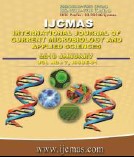


 National Academy of Agricultural Sciences (NAAS)
National Academy of Agricultural Sciences (NAAS)

|
PRINT ISSN : 2319-7692
Online ISSN : 2319-7706 Issues : 12 per year Publisher : Excellent Publishers Email : editorijcmas@gmail.com / submit@ijcmas.com Editor-in-chief: Dr.M.Prakash Index Copernicus ICV 2018: 95.39 NAAS RATING 2020: 5.38 |
Diabetes mellitus is a global epidemic and diabetic foot ulcer (DFU) is one of its serious complications. Diabetic foot infections are mixed bacterial infections and proper management of these infections requires an appropriate antibiotic selection based on the isolated organism. Type 2 diabetic patients affected with DFU and examined under Wagner‘s classification 1-5 were included in the study. Two swabs were collected from diabetic foot ulcer of each patient and the aerobic bacteria were identified and their antibiogram was studied. It was found that 80.70% of the wounds were monobacterial and 19.30% were polybacterial in nature. Gram negative bacteria were predominant than Gram Positive ones. Based on our antibiotic sensitivity results Aminoglycosides and Fluroquinolones were more effective against Gram Negative bacteria and Tetracyclines and Oxazolidinone against Gram Positive Bacteria. The authors suggest prompt initiation of antibiotic therapy thereby reducing the burden of diabetic foot infections and preventing morbidity.
 |
 |
 |
 |
 |